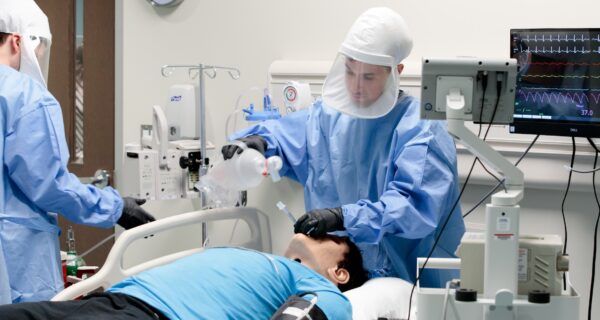
Residents practice intubating a Covid-19 positive patient wearing PPE in the clinical simulation center.

Heard at HLTH 2024: Insights from Innovative Healthcare Executives
Executives from Imagine360, Verily, BrightInsight, Lantern, and Rhapsody shared their approaches to reducing healthcare costs and facilitating digital transformation.
A historical criticism of healthcare industry is that it is slow to change. Faced with the pandemic however, providers had to shift their clinical protocols and train staff overnight to adapt to the changes the moment demanded. For one academic medical center in Nebraska, that meant resorting to patient simulation.
Called the Interprofessional Experiential Center for Enduring Learning or IEXCEL, the center offers advanced simulation and visualization technologies for medical training. It was established through a collaborative funding effort involving the state of Nebraska, city of Omaha, federal government and philanthropists. While it is located at the Davis Global Center at University of Nebraska Medical Center in Omaha, the center is connected to remote training sites in the state through interactive programs and live virtual events, said Pamela J. Boyers, associate vice chancellor of clinical simulation at iEXCEL, in an email.
“The goal [of iEXCEL is] to create a transformative model for health professions education,” she said.
Patient simulation allows healthcare students and practitioners to develop the technical and professional skills required in their chosen fields without the risks inherent in managing human patients.

Health Executives on Digital Transformation in Healthcare
Hear executives from Quantum Health, Surescripts, EY, Clinical Architecture and Personify Health share their views on digital transformation in healthcare.
Use of simulation is by no means new in the healthcare field — a survey conducted a decade ago by the Association of American Medical Colleges found that more than 80% of medical schools had incorporated simulation-based training within all four years of the curriculum. Since then, research reports have continued to show that the technology is effective for training in medical education.
Designed and constructed over five years, UNMC’s center opened last March, just as the Covid-19 pandemic hit.
“We immediately turned our attention to providing specialized training for healthcare professionals so that they could protect themselves and their patients,” Boyers said. “Due to the wide array of simulation technology and experienced staff in the Davis Global Center, we were able to provide ‘just in time’ training for healthcare professionals working on the front lines.”
Healthcare workers were trained on proper donning and doffing procedures for personal protective equipment, communication and teamwork skills in full PPE and accurate nasopharyngeal swabbing techniques — all essential protocols while taking care of highly infectious Covid-19 patients. The training included virtual reality simulation as well as hand-on training with manikins that can replicate physiological changes. Trainees included UNMC students and residents, Nebraska Medicine clinicians, as well as healthcare professionals from other organizations.
By the end of 2020, over 12,500 trainees were using the facility.
The 192,000-square-foot Davis Global Center offers simulation technology for different types of care, including a home care unit, biocontainment clinical training and simulation unit and a wide range of simulated hospital units. It also provides 3D augmented reality/virtual reality platforms such as a holographic theater.
Gaumard Scientific, a company that designs, manufactures and sells patient simulators, provided some of the technology for UNMC’s medical simulation facility.
Clinical simulation technologies have been gaining popularity over the past few years as the learners coming into medical and nursing schools have grown up with gaming, phone and tablet technology, said Jim Archetto, vice president of U.S. sales for Gaumard Scientific, in an email.
“…the old days of sitting in a lecture hall [are] really gone,” he said. “People learn very differently now.”
This has led to a global market for the medical simulation valued at approximately $2.1 billion in 2020, and a proliferation of companies providing medical simulation technology, including CAE Healthcare, OSSimTech and Osso VR, which recently raised $27 million in funding.
Gaumard Scientific focuses on improving the competency level of healthcare professionals across a range of accidents and illnesses. It provides patient simulators — mannikins that are wirelessly controlled from a tablet — that enable the operator training the students to control physiological changes from a distance. The technology is able to simulate a range of physiological responses for different types of patients.
For example, Gaumard has a simulator that can replicate the exact physiological response of a 5-year old getting stung by a bee, or having a traumatic brain injury, or an asthmatic attack, Archetto said. They also have birthing simulator — a mannikin that is the same size and weight as an average adult woman that delivers a robot baby.
In addition, mannikins supplied by Gaumard can replicate the respiratory issues often seen in Covid-19 patients, allowing health professionals outside of respiratory care to train on the use of ventilators.
The company works closely with physicians to understand how they are treating patients and incorporate that knowledge into the development of their simulators.
“Clinical simulation provides an important adjunct for training,” Archetto said. “Students practice both clinical skills and critical thinking on lifelike patient simulators that reproduce a patient’s clinical condition. This allows the learner to gain valuable experience with new techniques long before they advance to a true clinical situation.”
Photo: University of Nebraska Medical Center








